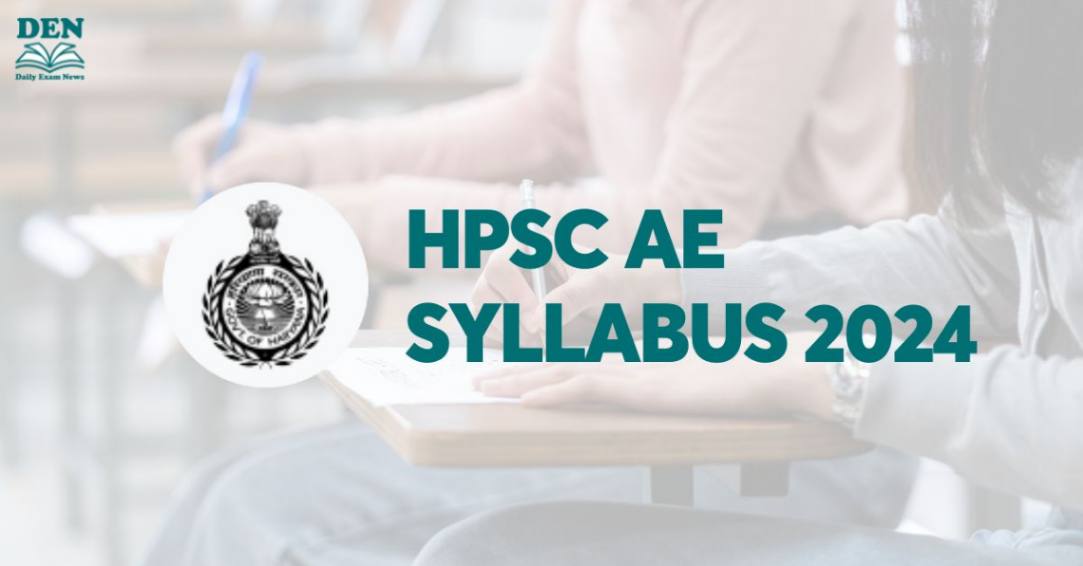The HPSC AE Syllabus 2024 is made available on the website of Haryana Public Service Commission through an official notification. For the Assistant Engineer examination, it encompasses essential subjects and their respective topics. Aspirants must focus on areas including General English, General Awareness, and Reasoning Ability, covering logical reasoning and problem-solving skills. Additionally, the Quantitative Aptitude section requires proficiency in mathematics topics such as algebra, geometry, and statistics. When it comes to technical disciplines, applicants should focus on specific subjects related to their engineering field, such as mechanical, electrical, or civil engineering. With a total of 1000 marks, the exam is split between objective and descriptive sections, guaranteeing a comprehensive assessment of the applicants’ knowledge and abilities. Read the article below if you are preparing for the HPSC AE Civil exam.
HPSC AE Syllabus 2024
The purpose of the HPSC AE Syllabus 2024 is to thoroughly evaluate applicants’ knowledge of a range of topics pertinent to the role of Assistant Engineer. In addition to portions on specialized topics like mechanical, electrical, and civil engineering, it also covers general English, general awareness, reasoning ability, and quantitative aptitude. The syllabus includes a broad range of topics, including technical disciplines like fluid physics, structural analysis, and thermodynamics, as well as current events, historical knowledge, and English grammar and understanding.
General Awareness Syllabus
| General Awareness Topics | Description |
| History of India and Haryana State | Important historical events and movements in India and Haryana. |
| Indian Polity and Constitution | Structure, functioning, and features of the Indian political system and the Constitution. |
| Geography (Indian and Haryana State) | Physical, social, and economic geography of India and Haryana. |
| Economics | Basic economic principles, Indian economy, and economic policies. |
| Current Affairs | Recent happenings in national and international events. |
| Science and Technology | Developments and advancements in science and technology. |
| Awards and Honors | Recognition given to individuals and organizations in various fields. |
| Prominent Personalities | Notable figures in various domains such as politics, science, literature, and arts. |
| Arts and Culture | Cultural heritage, traditions, and arts of India and Haryana. |
| Sports | Important sports events, tournaments, and achievements. |
HPSC AE General English Syllabus
| Topics covered in General English Syllabus for HPSC AE Exam | |
| General English Topics | Description |
| Grammar | Understanding and applying rules of English grammar. |
| Synonyms and Antonyms | Identifying words with similar or opposite meanings. |
| Error Detection | Finding and correcting grammatical errors in sentences. |
| Sentence Formation and Improvement | Forming sentences correctly and improving the structure of existing sentences. |
| Fill in the Blanks | Completing sentences by filling in the missing words. |
| Idioms and Phrases | Understanding and using common idioms and phrases. |
| One Word Substitution | Replacing phrases with a single word that conveys the same meaning. |
| Comprehension | Reading and understanding passages, followed by answering related questions to demonstrate comprehension. |
HPSC AE Quantitative Aptitude Syllabus
| Topics covered in Quantitative Aptitude syllabus for HPSC AE exam | |
| Quantitative Aptitude Topics | Description |
| Average | Calculating the mean of a set of numbers. |
| Ratio and Proportion | Solving problems involving ratios and proportions. |
| LCM & HCF | Finding the Least Common Multiple and Highest Common Factor of numbers. |
| Percentage | Calculating percentages and solving related problems. |
| Number System | Understanding and solving problems related to different number systems. |
| Simple and Compound Interest | Calculating interest using simple and compound methods. |
| Profit and Loss | Solving problems related to profit, loss, and discounts. |
| Time and Work | Calculating work done and time taken in various scenarios. |
| Pipes and Cistern | Solving problems related to the flow of liquids in pipes and cisterns. |
| Time and Distance | Solving problems involving speed, distance, and time. |
| Mixture and Allegation | Solving problems related to mixing of two or more substances. |
| Algebra | Solving equations and algebraic expressions. |
| Geometry | Understanding and solving problems related to shapes, sizes, and properties of figures. |
| Trigonometry | Solving problems involving trigonometric ratios and identities. |
| Statistics | Analyzing data and solving problems related to mean, median, mode, and standard deviation. |
Reasoning Ability Syllabus
| Topics Covered in Reasoning Ability Syllabus | |
| Reasoning Ability Topics | Description |
| Series | Identifying patterns and completing sequences. |
| Odd One Out | Finding the element that does not fit in a given set or pattern. |
| Coding Decoding | Deciphering codes and patterns in letters and numbers. |
| Seating Arrangement | Arranging people or items in a specified order based on given conditions. |
| Blood Relation | Solving problems related to family relationships. |
| Decision Making | Making logical decisions based on given scenarios. |
| Statement and Arguments | Analyzing arguments and determining the validity of statements. |
| Figure Counting | Counting geometric shapes within a larger figure. |
| Mirror and Water Images | Identifying mirror and water reflections of given shapes. |
| Direction and Distance | Solving problems related to directions and distances. |
| Arithmetical Reasoning | Applying arithmetic operations to solve logical problems. |
| Clock and Calendar | Solving problems related to time and dates. |
| Non Verbal Reasoning | Solving problems involving visual and spatial reasoning. |
Civil Engineering subjects and Syllabus
| Subjects | Syllabus |
| Paper – I Civil Syllabus | |
| Building Materials and Construction | Stones, Timber, Bricks, Cement, Mortar, Concrete, Masonry, Steel |
| Solid Mechanics | Stresses, Strains, Failures, Theories of Solid Material, Simple Bending and Torsion Theories, Shear Centre |
| Graphic Static | Force Polygon, Stress diagram |
| Structural Analysis | Analysis of trusses and frames, Introduction to plastic Analysis |
| Design of Metal Structure | Working stress and ultimate strength design of simple structures |
| Design of Concrete and Masonry Structures | Design of masonry walls, working stress design of plain, reinforced and prestressed concrete, ultimate strength design of reinforced and prestressed concrete |
| Paper – II | |
| Fluid Mechanics, Water Resources Engineering | Open channel and pipe flow, Hydrology Design of canals and hydraulics structures |
| Soil Mechanics and Foundation Engineering | Strength parameters, Earth pressures Theories, Design of Shallow and Deep foundations |
| Transportation Engineering | Railway Engineering and Surveying, Roads Superelevation, Ruling gradient pavements, Traffic controls, Design Consideration |
| Environmental Engineering | Water purifications, Sewerage treatment and disposal |
| Construction Planning and Management | Elements of construction practice, Bar charts, CPM, PERT |
| Paper – I | Mechanical Syllabus |
| Thermodynamics | Laws, Properties of ideal gases and vapours, Power Cycles, Gas Power Cycles, Gas Turbine Cycles, Fuels and Combustion |
| IC Engines | Fuel Injection and carburation, Performance and Testing, CI and SI engines, Detonation, Turbojet and Turbo-prop Engines, Rocket Engines, Elementary Knowledge of Nuclear Power Plants and Nuclear Fuels |
| Steam Boiler, Engines, Nozzles and Steam Turbines | Modern boilers, Steam Turbines types, Flow of Steam through nozzles, Velocity diagrams for impulse and Reaction Turbines, Efficiencies and Governing |
| Compressors, Gas Dynamics and Gas Turbines | Reciprocating Centrifugal and axial flow compressor, Velocity diagrams, Efficiency and Performance, Effect of Mechanical number on flow, Isentropic flow, Normal Shocks and Flow through nozzles, Gas Turbine Cycle with multistage compression, Reheating and Regeneration |
| Heat Transfer, Refrigeration and Air-conditioning | Conduction, Convection and Radiation, Heat exchangers and types combined, Heat Transfer, Overall Heat Transfer coefficient, Refrigeration and heat pump cycles, Refrigeration systems, Coefficient of performance, Psychometrics and psychometric chart, Comfort indices, Cooling and dehumidification methods, Industrial-Air Conditioning Process, Cooling and heating loads calculations |
| Properties and classification of fluid | Fluid statics, kinematics and dynamics, Principles and applications, Manometry and Buoyancy, Flow of ideal fluids, Laminar and turbulent flows, Boundary layer theory, Flow over immersed bodies, Flow through pipes and open channels, Dimensional analysis and similitude technique, Non-dimensional specific speed and classification of fluid mechanics in general, Energy transfer relation, performance and operation of pumps and of impulse and reaction water turbines, Hydrodynamic power transmission |
| Paper – II | |
| Theory of Machines | Velocity and acceleration (i) of moving bodies (ii) in machines. Klien’s construction, Inertia forces in machines, Cams, Gears and Gearing, Flywheels and Governors, Balancing of Rotating and Reciprocating masses, Free and forced vibrations of systems, Critical speeds and whirling of shafts |
| Machine Design | Design of Joints- Threaded fasteners and Power Screws-Keys, Kotter’s Coupling, Welded Joints, Transmission system- Belt and chain drives-wire ropes-shafts, Gears- Sliding and Rolling bearings |
| Strength of Materials | Stress and strain in two dimensions; Mohr’s circles: relations between Elastic Constants, Beams-Bending moments, shearing forces and reflection, Shafts-combined bending, direct and torsional stresses, Thick Walled cylinder and spheres under Pressure, Springs Struts and columns, Theories of failure |
| Engineering Materials | Alloys and Alloying Materials; heat treatment, Composition, properties and uses, Plastics and other newer engineering materials |
| Production Engineering | Metal Machinery: Cutting Tools: Tool Materials, Wear and Machinability, measurement of cutting forces, Process: Machining Grinding, Boring, Gear, Manufacturing, Metal Forming, Metal Casting & Jointing, Basic Special Purpose, Programme and numerically controlled machine tools, Jigs and fixtures (locating elements) |
| Industrial Engineering | Work study and work measurement, Wage incentive, Design of Production System and Product Cost, Principles of Plant layout, Production Planning and Control Material handling, Operations Research, Linear Programming, queuing Theory, Value Engineering, Network Analysis CPM and PERT, Use of computers |
HPSC AE Exam Pattern
There will be two sections to the exam: the objective and the descriptive. The objective section will include multiple-choice questions to assess the applicants’ knowledge and comprehension, and the descriptive section will assess how well they can express and apply their information in writing. With a total of 1000 marks available for the exam, applicants’ subject-matter expertise will be thoroughly evaluated. Refer to the table below for more details about the exam pattern.
| HPSC AE Exam Pattern 2024 | |||
| Sr. No | Subjects | Marks | Duration |
| Part – I Objective Type Paper | |||
| General Ability Test(Part A: General English)(Part B: General Studies) | 200 | 2hrs | |
| Technical Paper -I (Civil or Mechanical) | 200 | 2 hrs | |
| Technical Paper -II (Civil or Mechanical) | 200 | 2 hrs | |
| Part – II Conventional Papers | |||
| Technical Paper -I (Civil or Mechanical) | 200 | 3 hrs | |
| Technical Paper -II (Civil or Mechanical) | 200 | 3 hrs | |
| Total | 1000 | ||
Interview Exam Pattern
Those who receive 50% overall and at least 40% in each topic will be invited to the interview round. The interview phase will carry a 125-point weighting. To pass this round with high scores, the candidate needs to be well-versed in the relevant field and possess strong communication skills.
Check here for more information-
Hopefully, this information was useful for all the aspiring candidates preparing for the government exams. Check DailyExamNews to stay informed about the latest recruitments, tests, vacancies, and developments regarding government exams.

